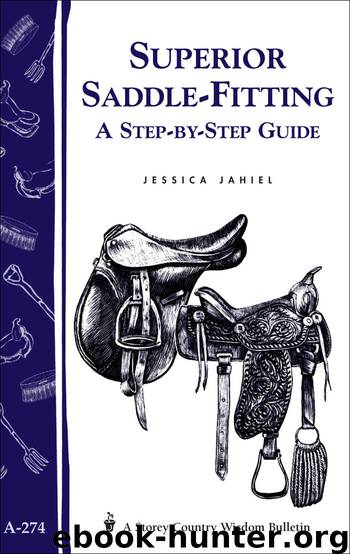Superior Saddle Fitting: A Step-by-Step Guide

Author:LLC Storey Publishing
Language: eng
Format: epub
Publisher: Storey Publishing, LLC
Published: 2000-03-26T16:00:00+00:00
With the girth tightened, stand behind the horse and look through the saddle gullet. This will serve as another check for the saddletree’s straightness, and the light that you see through the gullet will reassure you that the saddle fits, up to this point, anyway.
Now, get on the horse, and have your assistant look through the saddle gullet. Light should still be visible. If light is visible and the saddle feels comfortable to you, perform the chalk test.
Perform the Chalk Test. Remove the saddle from the horse’s back by lifting it off the horse. Shake powder or chalk over the horse’s back, then place the clean saddle pad and the saddle carefully and precisely on the horse’s back. If the shop permits you to use stirrups, cover them with plastic wrap or old tube socks to keep the leathers from marking the saddle. Fasten the girth, then mount carefully from a tall mounting block. Ride for 5 to 10 minutes, then dismount carefully, using the mounting block. Again, remove the saddle by lifting it off the horse. Remove the pad in the same way, being careful not to rub it against the horse.
Study the pad. If the chalk is distributed lightly and evenly, the saddle fit is good and you should feel free to saddle up and take a test ride. There should be no chalk down the center of the pad in the area of the horse’s spine. If there are spots with heavy chalk marks and other areas showing no chalk at all, the saddle is putting pressure on the chalk-marked areas and is not in contact with the unmarked areas — the saddle does not fit. Do not take a test ride.
Saddle-Buying Etiquette
When purchasing a saddle from a tack shop, it is usually necessary to pay in full, then take the saddle home to try it on the horse. Generally, a saddle can be returned if there are no marks on it and it has not been damaged, provided that it wasn’t a custom order or an item on special sale. If the saddle is being shipped to the rider, the rider is responsible for paying shipping costs for delivery; the same is true in the case of returns. This extra expense — generally less than $100 — adds up quickly if the rider has to try, say, five or more saddles. Knowing how to fit your horse properly will save both money and time, and your horse will thank you.
Download
This site does not store any files on its server. We only index and link to content provided by other sites. Please contact the content providers to delete copyright contents if any and email us, we'll remove relevant links or contents immediately.
| Riding | Showing & Training |
Finding Gobi by Dion Leonard(2783)
Grumpy Cat by Grumpy Cat(2691)
A New Earth: Awakening to Your Life's Purpose by Eckhart Tolle(2600)
The Silkworm by Robert Galbraith(2446)
Tippi by Tippi Hedren(2188)
End of Days by Sylvia Browne(2118)
Total Cat Mojo by Jackson Galaxy(1970)
Backyard Chickens Beyond the Basics by Pam Freeman(1905)
The Animals Among Us by John Bradshaw(1831)
The Ultimate Pet Health Guide by Gary Richter(1730)
All Things Bright and Beautiful by James Herriot(1710)
Vet in Harness by James Herriot(1667)
Doggy Desserts: 125 Homemade Treats for Happy, Healthy Dogs by Cheryl Gianfrancesco(1655)
Dog Years by Mark Doty(1646)
Cesar's Way by Cesar Millan(1639)
Chicken Soup for the Ocean Lover's Soul by Jack Canfield(1603)
Dog Training 101 by Kyra Sundance(1561)
Walking with Peety by Eric O'Grey(1557)
Animal Speak by Ted Andrews(1520)
